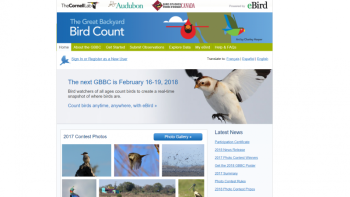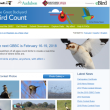Birth of the Great Backyard Bird Count
Early one fall morning more than 22 years ago, we and 10 or so of our colleagues from the Cornell Lab of Ornithology piled into a large, white van. We rode south from Ithaca, New York, for about four hours into western Pennsylvania chatting excitedly with our leader, John Fitzpatrick. As the director of the Cornell Lab of Ornithology, Fitz, as he preferred to be called, had grand ideas for a new project that would revolutionize birding and citizen science. He had started a conversation about some of the ideas with a number of influential ornithologists and birders including Frank Gill. Frank had recently left a long-time position at the Philadelphia Academy of Natural Sciences to become head of science for National Audubon, and he was equally excited about these new ideas.
The van stopped in front of an unassuming building in a small clearing surrounded by forest, almost like a country grange hall. Inside were Frank and a group of Audubon science department folks. At the end of an enjoyable day filled with grand visions tempered with technological limitations, the plan for the first Great Backyard Bird Count was born.
When it launched in 1998, it was the first time a citizen science project would allow people from across a continent to input their bird sightings into a national database and see their results in real time as the count unfolded. Great Backyard Bird Count 1998 provided a four-day snapshot of the distribution and abundance of birds across the U.S. and Canada. That launch year was incredibly exciting as our grand plan tested the technology that had been developed by a skilled team of computer and internet developers and designers. In the weeks before, much work had gone into contacting hundreds of media outlets to make the world aware of this, the first-ever Great Backyard Bird Count.
Over the weekend of the count, we all hovered at the Lab of Ornithology headquarters at Sapsucker Woods (not in the big, shiny headquarters that is there today but in the old cinder block building and, in particular, the trailers across the street, where some pretty great minds were housed), watching the computer screens as the checklists rolled in.
That first year, we were extremely gratified to have 13,500 checklists submitted from the U.S. and Canada. It was a wild success!
Today, 21 years later, the Great Backyard Bird Count is open to the entire world. Last year, 181,659 checklists were submitted from all over the planet tallying more than 29 million individual birds.
In North America, the most frequently reported birds tend to stay about the same from year to year with mourning dove, northern cardinal, dark-eyed junco, American crow, and blue jay always at the top. The most abundant species can vary a bit, although usually American robin, European starling, snow goose, Canada goose, and red-winged blackbird are near the top.
Not surprisingly, big states like New York, Pennsylvania, and California are usually at the top for most checklists submitted, though we can say with a cheer that in Great Backyard Bird Counts’ very first year (1998), Maine came in second for most checklists submitted!
Last year, 1,102 checklists were submitted from Maine with a grand total of 117 species. Wouldn’t it be great to put Maine on the map in a big way again?
This year’s Great Backyard Bird Count is taking place from February 16-19. Anyone can submit bird sightings by going to the website: http://gbbc.birdcount.org/ Please mark your calendar and plan to participate. It’s easy, fun, and you’ll be part of a great team of citizen scientists located all over the world, and right here in Maine. We hope you’ll join us!
Jeffrey V. Wells, Ph.D., is a Fellow of the Cornell Lab of Ornithology. Dr. Wells is one of the nation's leading bird experts and conservation biologists and author of “Birder’s Conservation Handbook”. His grandfather, the late John Chase, was a columnist for the Boothbay Register for many years. Allison Childs Wells, formerly of the Cornell Lab of Ornithology, is a senior director at the Natural Resources Council of Maine, a nonprofit membership organization working statewide to protect the nature of Maine. Both are widely published natural history writers and are the authors of the book, “Maine’s Favorite Birds” and the newly published “Birds of Aruba, Bonaire, and Curaçao” from Cornell Press.
Event Date
Address
United States
























